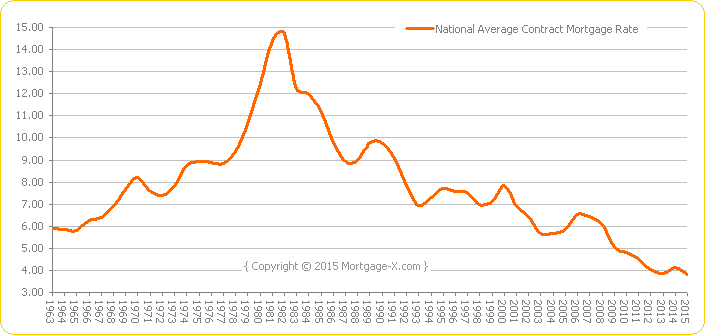If you want to buy a home, now is the time, and if you don’t act soon, you will regret it. Here’s a key reason why: historically low interest rates. As of today, the average 30-year fixed-rate loan with no points or fees is below 4%. That, as the graph below”which you can find on Mortgage-X.com”shows, is the lowest the rate has been in nearly 40 years.

In fact, rates are so well below historic averages that it should make all current and prospective homeowners take notice of this once-in-a-lifetime opportunity.
In 1970 rates were approximately 7.25%. After hovering there for a couple of years, they began a trend upward, landing near 10% in late 1973. They settled at 8.5% to 9% from 1974 to the end of 1976. After the rise to 10%, that probably seemed O.K. to most home buyers.
But they weren’t happy soon thereafter. From 1977 to 1981, a period of only 60 months, the 30-year fixed rate climbed to 18%!
Interest Rate Lessons
And when rates started to decline after that, they took a long time to recede to previous levels. They hit 9% for a brief time in 1986 and bounced around 10% to 11% until 1990. For the next 11 years through 2001, the rates slowly ebbed and flowed downward, ranging from 7% to 9%. We™ve since spent the last nine years, until very recently, at 6% to 7%. So you can see why 5% is so remarkable.
So, what can we learn from the historical trends and numbers?
First, rates have far further to move upward than downward; for more than 30 years, 7% was the low and 18% the high. The norm was 9% in the 1970s, 10% in the mid-1980s through the early 1990s, 7% to 8% for much of the 1990s, and 6% only over the last handful of years.
Second, the last time the long-term trends reversed from low to high, it took more than 20 years (1970 to 1992) for the rate to get back to where it was, and 30 years to actually start trending below the 1970 low.
Finally, the most important lesson is to understand the actual financial impact the rate has on the cost of purchasing and paying off a home.
Every quarter-point change in interest rates is equivalent to approximately $6,000 for every $100,000 borrowed over the course of a 30-year fixed. While different in each region, for the sake of simplicity, let’s assume that the average person is putting $40,000 down and borrowing $200,000 to pay the price of a typical home nationwide. Thus, over the course of the life of the loan, each quarter-point move up in interest rates will cost that buyer $12,000.
Loan Costs
Stay with me now. We are at 4%. As you can see by the graph above, as the economy stabilizes, it is reasonable for us to see 30-year fixed rates climb to 6% within the foreseeable future and probably to a range of 7% to 8% when the economy is humming again. If every quarter of a point is worth $12,000 per $200,000 borrowed, then each point is worth almost $50,000.
Let’s put that into perspective. You have a good stable job (yes, unemployment is at 10%, but another way of looking at that figure is that most of us have good stable jobs). You would like to own a $240,000 home. However, even though home prices have steadied, you may be thinking you can get another $5,000 or $10,000 discount if you wait. Or you may be waiting for the news to tell you the economy is more stable and it’s safe to get back in the pool (in case you hadn’t noticed the national news has just started to do so and this is increasing demand which will soon begin to drive up prices as inventory levels decline). In exchange for what you may think is prudence, you will risk paying $50,000 more per point in interest rate changes between now and the time you decide you are ready to buy. And you are ignoring the fact that according to the Case-Shiller index, home prices in most regions have been trending back up for the last several months.
If you are someone who is looking to buy or upgrade in the $350,000-to-$800,000 home price range, and many people out there are, then you’re borrowing $300,000 to $600,000. At 7%, the $300,000 loan will cost just under $150,000 more over the lifetime, and the $600,000 loan an additional $300,000, if rates move up just 2% before you pull the trigger.
What I’m trying to impress upon everyone is that if you are planning on being a homeowner now and/or in the foreseeable future, or if you are looking to move your family into a bigger home, then pay more attention to the interest rates than the price of the home. If you have a steady job, good credit, and the down payment, then you really are being offered the gift of a lifetime.
If you, or someone you know is considering Buying or Selling a Home in Columbus, Ohio please contact The Opland Group. We offer professional real estate advice and look forward to helping you achieve your real estate goals!
The Opland Group Specializes in Real Estate Sales, Luxury Home Sales, Short Sales in; Bexley Columbus Delaware Downtown Dublin Gahanna Grandview Heights Granville Grove City Groveport Hilliard Lewis Center New Albany Pickerington Polaris Powell Upper Arlington Westerville Worthington



